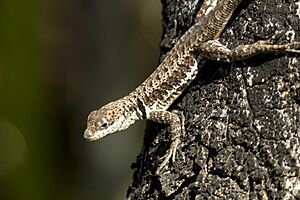Tropidurus torquatus facts for kids
Quick facts for kids Tropidurus torquatus |
|
|---|---|
 |
|
| Conservation status | |
| Scientific classification | |
| Genus: |
Tropidurus
|
| Species: |
torquatus
|
| Synonyms | |
Tropidurus torquatus is a type of lizard often called the Amazon lava lizard. It belongs to a group of lizards known as Neotropical ground lizards. This lizard is special because it only lives in South America. You won't find it naturally anywhere else in the world! There are no different types or subspecies of this lizard.
Contents
What's in a Name?
The lizard's scientific name, torquatus, comes from Latin. It means "adorned with a neck chain or collar." This name likely describes a feature of the lizard's appearance.
Where Does It Live?
The Amazon lava lizard is native to South America. You can find it in many countries there. These include Argentina, Bolivia, Brazil, Colombia, French Guiana, Guyana, and Suriname. It is one of the most common lizards in its group, the Tropidurus genus.
What Does It Look Like?
The Tropidurus torquatus is a medium-sized lizard. It has a head that is quite large compared to its body. Its scales overlap each other, like roof tiles. Adult females are usually about 7 to 10 centimeters (about 3 to 4 inches) long from their snout to the base of their tail. Males are a bit bigger, often 11 to 12 centimeters (about 4 to 5 inches) long.
Where Does It Live? (Habitat)
This lizard mostly lives in open areas. It especially likes a type of coastal forest called restinga, which is part of the Atlantic Forest. It can even live in restinga areas that have been changed or damaged by people. It has also been found on islands, showing it can travel to new places. You might also see it in the Cerrado, a large grassland area. Sometimes, it even lives in neighborhoods, where it's good at climbing house walls! It mostly stays on the ground. It likes to live in termite nests, or on and under rocks and logs. Many other animals live near it, like giant ameivas, coatis, and even false coral snakes.
What Does It Eat?
The Amazon lava lizard is an omnivore. This means it eats both animals and plants. It enjoys eating small creatures without backbones, called invertebrates. It also eats parts of plants. Its favorite food is ants. When it eats plants, it prefers fruits and flowers. It often eats the fruit from plants like Chomelia obtusa, higuerón, and smilaxes. In the summer, it especially loves the fruit of the little coca plant.
Protecting Its Space
Male Tropidurus torquatus lizards are very territorial. This means they protect their own space from other males. They show off by bobbing their heads and whipping their tails. They can also be aggressive, chasing and fighting other males. Bigger and faster males usually get the best territories. These good spots have lots of places to hide and plenty of sunlight. Females prefer these better territories and will choose the males who guard them. A male with a good territory might have several females living in his area.
Reproduction
Female Tropidurus torquatus lizards lay eggs. They might lay several eggs at once. However, laying two eggs is very common, especially for lizards living near the coast. In other areas, they might lay more eggs in one clutch.
Running on Two Legs
One cool thing about the Tropidurus torquatus is that it can sometimes run on its hind legs! This is called bipedal locomotion. It can run quite fast on two feet for a short distance. When it runs, it holds its body at an angle. It lifts its back legs high and swings its front legs at the same time. For example, its right front leg swings forward when its right back leg comes up.


